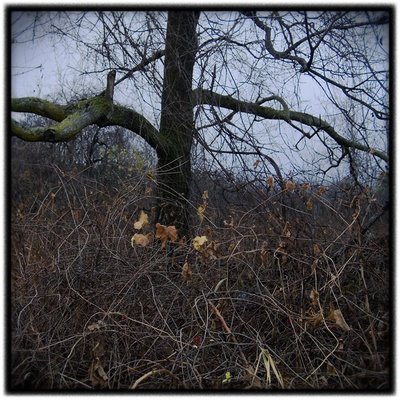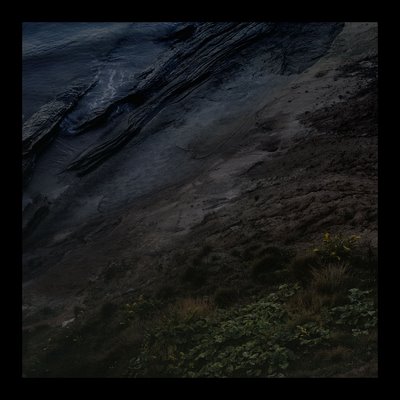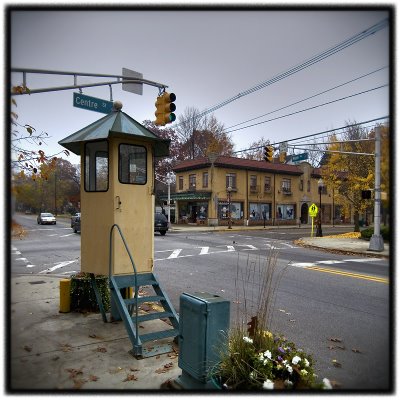Saturday, November 18, 2006
Friday, November 17, 2006
ku # 438 and a book review (of sorts)

So I'm watching a program segment on the tube last night. It was a mini feature about a photographer acquaintance - Mark Bowie - who is fast becoming the new "dean" of Adirondack photography. This is primarily due to the fact that his work is featured regularly in Adirondack Life Magazine.
The segment revolved mainly around his new book, Adirondack Waters - Spirit of the Mountains. Now understand that I use some of Mark's photography in various Adirondack tourism pieces I produce so I do respect the man's ability with a camera...
BUT...
The thought that entered my head about half way throught the segment was how utterly differently he and I "see" the Adirondacks. So much so, that even though I recognized most of the places in his book, it was as if I didn't recognize them at all. He had, through the magic of assiduously applied sentimental photographic technique, reduced the place to a series of ubiqutous picture postcards (an aside - if memory serves correctly, Mark's grandfather was one of the Adirondack's first and very prolific producers of Adirondack postcards).
I can't completely express the foreign-ness, the disassociation, the very estrangement I felt viewing his photographs. I think in large part this feeling came from the fact that, in addition to the aforementioned sentimentality quotient, most of the photographs were not created on a "human" scale - the scale that you can reach out and touch, smell and embrace. They seemed to command too much of the standoffish reverential - nature on a pedestal - that is so prevalent in mainstream nature/landscape photography.
He illustrated, with the fastidious craftmanship, the look of the place, but, IMconsideredO, and contrary to the book's subtitle, he illuminated none of the spirit of the place. Or, at best, he captured only the narrow-ist slice of that spirit - that found in sweeping golden light iconistic landscapes (FYI, the photography that I use to draw the tourists in). Pleasant enough as far as it goes - it just doesn't go nearly far enough.
As I mentioned, I know Mark. He's a serious-minded, well-educated kind of guy. His love of and enthusiasm for the Adirondacks is readily apparent to anyone who spends more than a few minutes around him. His technical command of the photographic medium is of the highest order, but I am left wondering why he seems to continue to, as Brooks Jensen states, create "what he has been told is a good photograph" and why he doesn't "photograph what he sees."
Perhaps Mark is too caught up in the lure of what sells and garners the most attention, although I am certain that he photographs the Adirondacks in a manner that genuinely comes from his heart.
At least that's how I see it.
Photopop 7.0

Repulsively inviting or least that's how this looks to me (gravitas). It's one of those photographs that I just can't seem to stop looking at. Not sure why.
FEATURED COMMENT: Kent Wiley wrote: "...It's a moldy car wash. What's the big deal?"
publisher's response - Sleepy LaBeef, one of my favorite American musicians - dubbed "The Human Jukebox", has a song titled It ain't what you eat, it's the way how you chew it. That notion taken together with the adage You are what you eat seems to offer a starting point with which to answer your question.
If a photography diet consists mainly of easy-to-digest, stating-the-obvious WOW (WithOut Weight) photographs (and I'm not saying that yours is), then an observer is probably not stretching his/her mental/emotional facilities all that much. In culinary speak, his/her taste buds are not very sophisticated.
If, on the other hand, an observer regularly challenges - one might even say "treats" - enriches his/her diet with more complex offerings, an ability to identify and appreciate subtle tastes and textures most often develops. In photography speak, he/she learns a new way of "seeing" that he/she can use to view and create photographs. In culinary speak he/she has learned a new way of chewing.
In simpler jargon, I guess the answer to your question is, "it all depends on how you look at it".
Thursday, November 16, 2006
Another Link
I discovered photo-musing through a heads-up from Jim Jirka and a subsequent steady flow of visitors to The Landscapist from that site. Thanks to Paul Butzi for the endorsement. photo-musing.blogspot.com is the product of Paul Butzi from the Pacific Northwest. He is also a contributor to Art and Perception.
The site has much of interest on offer. The site's subhead states all you need to know about Paul's perspective - "Musings on photography from an artist perspective and art from a photographer perspective" HIghly recommended reading.
The site has much of interest on offer. The site's subhead states all you need to know about Paul's perspective - "Musings on photography from an artist perspective and art from a photographer perspective" HIghly recommended reading.
ku # 437 and something rarely talked about in polite photographic circles

Yesterday was unseasonably warm. The day started very sunny but by late morning a deep grey shrouded the sky. Around 4pm there was a brief and tiny window in the western sky. As f8-and-be-there serendipity would have it, I was driving by this magnificent willow at that tiny-window moment.
As I was key-stroking yesterday's "thought", a then ill-formed notion popped into my head about the connection between a person's photography and their, for lack of a better psycho-babble term, personality. We all know, as the conventional wisdom goes, that Art is a reflection of its creator - "inner" vision and voice and all that.
This notion has been rattling and clanging around in my noodle for quite some time. Not that I doubt the validity of the notion, it's more that I have been trying to figure out what my photography says about me. I think I gave myself a clue in yesterday's "thought" - specifically the idea that "...it (the weather) is what it is and I take as it comes..." and "...I ,,, photograph what I see when I see it...".
Bingo.
There is a connection between the f8-and-be-there serendipity of ku # 437 (and almost all of my ku photography) and a take-it-as-it-comes "attitude" (preternatural, not adopted) that has pervaded my life. Big or small, I can't seem to plan anything. Just ask my f8-and-be-there serendipity wife who gets somewhat exasperated with the vacant stare she gets from me every time she asks something as simple as what I have planned for the weekend.
Even though f8-and-be-there serendipity could be considered one of the defining characteristics of me, my photography and my life, it is certainly, for purposes of this discussion about photography, not the only thing that forms my photographic vision/voice, but that's a topic for another time.
However, this excerpt from an interview with Paul Caponigro - FOCUS magazine, Dec. 2006 - is instructive:
"I was looking for a very core place, a place that functioned despite all the information and influence. I studied Gurdjieff, looking for reinforcement of what I already knew. When you talk about mysticism and the spirit, you are on pretty shakey ground. Discussion about it and ways of achieving it can be as much a hinderence as a help. I was aware that something in me knew something. Of all the systems that I studied, Gurdjieff provided the most practical approach to reaching that personal knowledge. It had nothing to do with whether or not you were going to be a better artist. Nothing! It had to do with developing your inner place, and once developed, you could apply it; it would automatically come into everything you did. My photographs are no better than my inner space. Gurdjieff teaches you that you must constantly work on your inner space."
And this from the American artist and teacher Robert Henri:
"The man who wants to procuce art must have the emotional side first...art...(is) the measure of the man."
On a purely person note, this measure of the man and no better than my inner space stuff is why I seem to have no respect for the pretty-picture gang. Their work is just shallow, and, by extension, at least to some extent, so are the "artists" - not that I think that they are "bad" people, I just don't want my step daughter to marry one.
Maybe f8-and-be-there should be changed to know-youself-and-be-there.
FEATURED COMMENT: Paul Butzi wrote:"If you don't live it, it won't come out your horn"--Charlie Parker
Wednesday, November 15, 2006
ku # 436 and a thought for your consideration

Maybe it's the time of year that has influenced the darkness of this photograph and those of Michel Legendre and Photopop 7.0. Collectively, we are in the grips of late afternoon sunset sets (4:27pm today) and add to that some gloomy overcast weather...
I can't speak for Michel or Photopop, but I usually don't complain about the weather - it is what it is and I take as it comes. I've even adapted to playing golf in the rain (light rain). I also photograph in the rain, something that I haven't seen much of in photographs. Certainly that is influenced by the desire of many to protect their gear but I suspect that most photographers just aren't "grabbed" by the light. They find it too drab and dreary and would probably prefer to spend their photographic time being all cheery and bright, creating photographs that are all beer and skittles.
And given our cultural preference for escapism and the avoidance of real reality, they are doing a good job of following the piper.
Me, I prefer to photograph what I see when I see it and, as much as is possible with the photographic medium, as it is. You might even say that I think reality bites - but make that "bites" as in jolts, invigorates, slaps in the face, awakens with a bang.
Michel Legendre ~ No content - substance as opposed to form

Death is present in all landscape photographs, although we seldom see it. Our eyes and minds filter out the fact that at a cellular level, life is a constant, cataclysmic cycle of death and rebirth and seize on the medium's ability to extend the life of the depicted moment's light, time place and people. Ferdinand Protman in - LANDSCAPE - photography of time and place -
FEATURED COMMENT: Michel Legendre wrote: "I love the "new" term deathscape...That idea of "death" and "cataclysmic cycle" that gives birth to forms that I can capture and use to create photography, is in fact in my mind since more than a year...I think IT IS the """substance""" in everything that I look at, in every form I create...You reactions help me to think it' s about time I put an end to that constant inner dialogue about "form" and "content" that made me stop shooting for a while recently."
Tuesday, November 14, 2006
Photopop 7.0

Photopop 7.0 has recently become fascinated by night photography. In all probablity this stems from his View the Commute photography/blog - the evening half of his commute (6 miles - no traffic, some might take issue with this drive as a "commute") is driven and photographed in the dark. He has discovered the oddly colorful world of out-of-whack WB and, I suspect, the hidden-mystery quality that can be inherent in night photography.
The fact is, I like night photography myself and I thought that you all might like to check out The Nocturnes
Mary Dennis ~ Little Blue Park

I think what drew me to this little blue park was the humorous convergence of reality with the "painted on." I'm not sure if the muralist intended it or not, but I love that zone at left middle where the fake tree and the real tree meld together. I've shown this image to several people and many of them have said that it looks like good usage of a very small urban space, but the park actually made me feel somewhat uneasy. Maybe it's the odd, unnatural color of the painting and the way the light hit the walls and bounced blue all over the place, but mostly it feels like a sad attempt to replicate something that has been lost or is fading fast.
This image was shot with a 2 megapixel, fixed-focus, setting-free Rolleiflex mini digital camera.
Monday, November 13, 2006
A link
Gravitas et Nugalis on TheOnlinePhotographer.blogspot.com
Mike Johnston's photography blog is on my list of daily must-visits. I have followed his in-print writings on photography for a long time. Can't recommend them enough - especially his book The Emperical Photographer, which he advises not to buy at this time because a 2nd edition is on the way.
from the book description on Lulu.com - Mike Johnston has published more than 100 articles about photography in magazines in the U.S. and England. He currently writes for BLACK & WHITE PHOTOGRAPHY and CAMERA ARTS magazines, and his popular column "The Sunday Morning Photographer" appears on the web on The Luminous Landscape, Steve's Digicams, and Photo.Net, and is translated into Polish, Hungarian, Portuguese, and Greek. In the past he was East Coast Editor of CAMERA & DARKROOM and Editor-in-Chief of PHOTO TECHNIQUES. THE EMPIRICAL PHOTOGRAPHER is a collection of the best of his critical articles and essays.
Mike Johnston's photography blog is on my list of daily must-visits. I have followed his in-print writings on photography for a long time. Can't recommend them enough - especially his book The Emperical Photographer, which he advises not to buy at this time because a 2nd edition is on the way.
from the book description on Lulu.com - Mike Johnston has published more than 100 articles about photography in magazines in the U.S. and England. He currently writes for BLACK & WHITE PHOTOGRAPHY and CAMERA ARTS magazines, and his popular column "The Sunday Morning Photographer" appears on the web on The Luminous Landscape, Steve's Digicams, and Photo.Net, and is translated into Polish, Hungarian, Portuguese, and Greek. In the past he was East Coast Editor of CAMERA & DARKROOM and Editor-in-Chief of PHOTO TECHNIQUES. THE EMPIRICAL PHOTOGRAPHER is a collection of the best of his critical articles and essays.
Urban ku # 6 and a last comment on HDR

Intersection of Center and Maple Merchantville, NJ.
Eric Fredine wrote (in part), "..I hardly ever see an HDR photograph where I don't immediately notice the halos. It's an inherent characteristic of the process.
I think HDR will be nothing but an interesting historical side-note - a work-around to a technical problem. Exactly the way graduated neutral density filters are (were?) used to overcome the limitations of slide film...."
I agree in as much as HDR/Tone Mapping software/technology is in its infancy and many improvements are needed for it to blossom into an "invisible" technique.
That said, however, I am still not certain after testing the HDR/TM waters - only skimming the surface of the many variables involved in creating a HDR/TM photograph - that obtaining "invisiblely" applied technique is not possible at this state of software development.
In any event, I still believe it behooves the involved photographer to at least familiarize him/her-self with what's going on out there in the HDR/TM paradigm.





